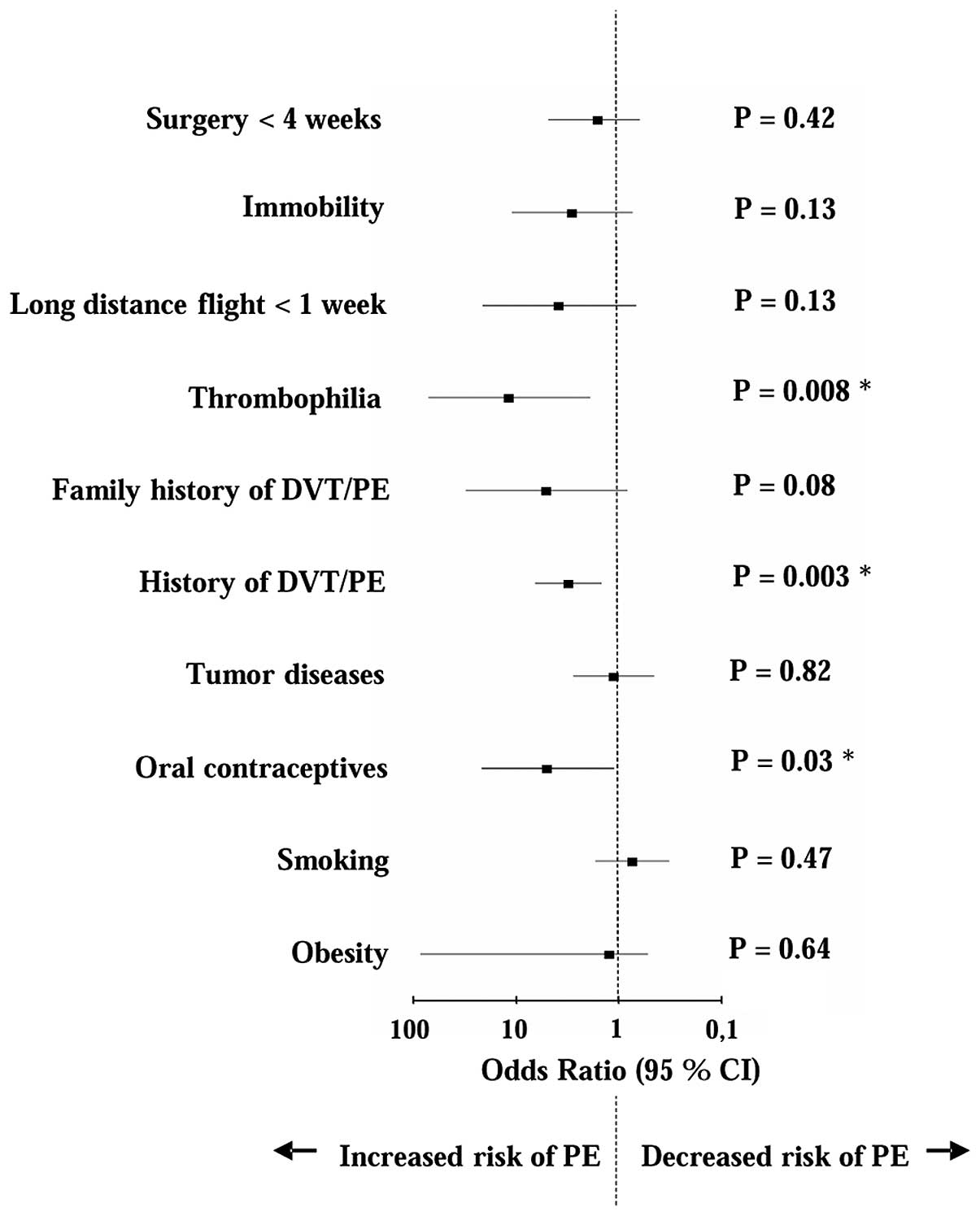|
1
|
Walther A and Böttiger BW: Pulmonary
embolism. Wien Med Wochenschr. 158:610–614. 2008.[(In German)].
View Article : Google Scholar : PubMed/NCBI
|
|
2
|
Horlander KT, Mannino DM and Leeper KV:
Pulmonary embolism mortality in the United States, 1979–1998: an
analysis using multiple-cause mortality data. Arch Intern Med.
163:1711–1717. 2003. View Article : Google Scholar : PubMed/NCBI
|
|
3
|
Goldhaber SZ: Pulmonary embolism. Lancet.
363:1295–1305. 2004. View Article : Google Scholar : PubMed/NCBI
|
|
4
|
Kline JA, Hernandez-Nino J, Jones AE, Rose
GA, Norton HJ and Camargo CA Jr: Prospective study of the clinical
features and outcomes of emergency department patients with delayed
diagnosis of pulmonary embolism. Acad Emerg Med. 14:592–598. 2007.
View Article : Google Scholar : PubMed/NCBI
|
|
5
|
Mullins MD, Becker DM, Hagspiel KD and
Philbrick JT: The role of spiral volumetric computed tomography in
the diagnosis of pulmonary embolism. Arch Intern Med. 160:293–298.
2000. View Article : Google Scholar : PubMed/NCBI
|
|
6
|
Perrier A, Howarth N, Didier D, et al:
Performance of helical computed tomography in unselected
outpatients with suspected pulmonary embolism. Ann Intern Med.
135:88–97. 2001. View Article : Google Scholar : PubMed/NCBI
|
|
7
|
Torbicki A, Perrier A, Konstantinides S,
et al: ESC Committee for Practice Guidelines (CPG): Guidelines on
the diagnosis and management of acute pulmonary embolism: the Task
Force for the Diagnosis and Management of Acute Pulmonary Embolism
of the European Society of Cardiology (ESC). Eur Heart J.
29:2276–2315. 2008. View Article : Google Scholar : PubMed/NCBI
|
|
8
|
Douma RA, Mos IC, Erkens PM, et al:
Performance of 4 clinical decision rules in the diagnostic
management of acute pulmonary embolism: a prospective cohort study.
Ann Intern Med. 154:709–718. 2011. View Article : Google Scholar : PubMed/NCBI
|
|
9
|
Le Gal G, Righini M, Roy PM, Sanchez O,
Aujesky D, Bounameaux H and Perrier A: Prediction of pulmonary
embolism in the emergency department: the revised Geneva score. Ann
Intern Med. 144:165–171. 2006. View Article : Google Scholar : PubMed/NCBI
|
|
10
|
Wells PS, Anderson DR, Rodger M, et al:
Derivation of a simple clinical model to categorize patients
probability of pulmonary embolism: increasing the models utility
with the SimpliRED D-dimer. Thromb Haemost. 83:416–420.
2000.PubMed/NCBI
|
|
11
|
Young MD, Daniels AH, Evangelista PT, et
al: Predicting pulmonary embolus in orthopedic trauma patients
using the wells score. Orthopedics. 36:e642–e647. 2013. View Article : Google Scholar : PubMed/NCBI
|
|
12
|
Gruettner J, Walter T, Bolte M, Haghi D,
Sudarski S and Henzler T: Incidence of pulmonary embolism in an
emergency department cohort evaluated with a simple symptom-based
diagnostic algorithm. In Vivo. 27:215–220. 2013.PubMed/NCBI
|
|
13
|
Calvo-Romero JM, Pérez-Miranda M and
Bureo-Dacal P: Syncope in acute pulmonary embolism. Eur J Emerg
Med. 11:208–209. 2004. View Article : Google Scholar : PubMed/NCBI
|
|
14
|
Castelli R, Tarsia P, Tantardini C,
Pantaleo G, Guariglia A and Porro F: Syncope in patients with
pulmonary embolism: comparison between patients with syncope as the
presenting symptom of pulmonary embolism and patients with
pulmonary embolism without syncope. Vasc Med. 8:257–261. 2003.
View Article : Google Scholar : PubMed/NCBI
|
|
15
|
Koutkia P and Wachtel TJ: Pulmonary
embolism presenting as syncope: case report and review of the
literature. Heart Lung. 28:342–347. 1999. View Article : Google Scholar : PubMed/NCBI
|
|
16
|
Miniati M, Prediletto R, Formichi B, et
al: Accuracy of clinical assessment in the diagnosis of pulmonary
embolism. Am J Respir Crit Care Med. 159:864–871. 1999. View Article : Google Scholar : PubMed/NCBI
|
|
17
|
Wolfe TR and Allen TL: Syncope as an
emergency department presentation of pulmonary embolism. J Emerg
Med. 16:27–31. 1998. View Article : Google Scholar : PubMed/NCBI
|
|
18
|
Goldhaber SZ, Grodstein F, Stampfer MJ, et
al: A prospective study of risk factors for pulmonary embolism in
women. JAMA. 277:642–645. 1997. View Article : Google Scholar : PubMed/NCBI
|
|
19
|
Kline JA and Miller DW: Risk
stratification for acute pulmonary embolism. J Natl Compr Canc
Netw. 9:800–810. 2011.PubMed/NCBI
|
|
20
|
Lauque D, Mazières J, Rouzaud P, et al:
Pulmonary embolism in patients using estrogen-progestagen
contraceptives. Presse Med. 27:1566–1569. 1998.[(In French)].
PubMed/NCBI
|
|
21
|
Lehmann R, Suess C, Leus M, et al:
Incidence, clinical characteristics and long-term prognosis of
travel-associated pulmonary embolism. Eur Heart J. 30:233–241.
2009. View Article : Google Scholar : PubMed/NCBI
|
|
22
|
Antman EM, Cohen M, Bernink PJ, et al: The
TIMI risk score for unstable angina/non-ST elevation MI: A method
for prognostication and therapeutic decision making. JAMA.
284:835–842. 2000. View Article : Google Scholar : PubMed/NCBI
|
|
23
|
Manzoli L, De Vito C, Marzuillo C, Boccia
A and Villari P: Oral contraceptives and venous thromboembolism: a
systematic review and meta-analysis. Drug Saf. 35:191–205.
2012.PubMed/NCBI
|
|
24
|
Wu O, Robertson L, Twaddle S, et al:
Screening for thrombophilia in high-risk situations: systematic
review and cost-effectiveness analysis. The thrombosis: risk and
economic assessment of thrombophilia screening (TREATS) study.
Health Technol Assess. 10:100–110. 2006. View Article : Google Scholar
|
|
25
|
Breen ME, Dorfman M and Chan SB: Pulmonary
embolism despite negative ELISA D-dimer: a case report. J Emerg
Med. 37:290–292. 2009. View Article : Google Scholar : PubMed/NCBI
|















